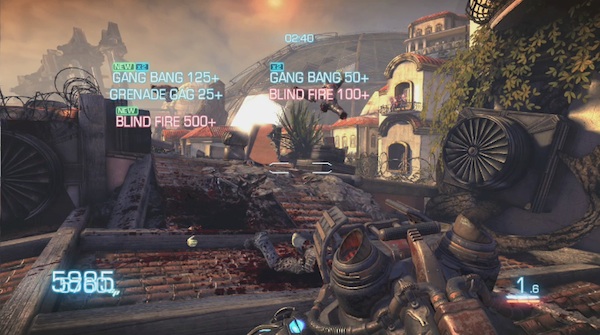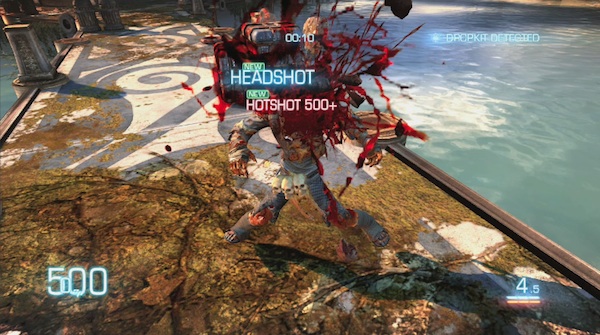This post has not been edited by the GamesBeat staff. Opinions by GamesBeat community writers do not necessarily reflect those of the staff.

Bulletstorm, the upcoming shooter from Epic and People Can Fly, is crass, juvenile, and, according to the bastions of journalism over at Fox News, maybe the most offensive video game in the world.
Forming the backbone of Bulletstorm’s gameplay — and at the heart of the Fox News controversy — is the “skillshot.” These creative kills (earned by, say, kicking a bad guy into an electrified fence or shooting him in the nuts) come with quaint names like “Drilldo” and “Gag Reflex.” They also act as the game’s currency, so the more skillshots you unlock, the quicker you’ll unlock new weapons and upgrades.
At a recent event for the game, I spoke with Lead Producer Tanya Jessen about the origin of the skillshot concept, how it evolved over the course of the game, who came up with those…interesting names, and more.
Bitmob: How did the concept of the skillshot evolve over the course of development? Was it present when Epic first saw the game?
Tanya Jessen: No. When we first started making Bulletstorm, we knew that we wanted to do an over-the-top sci-fi shooter. But what we also knew is that we wanted it to be pure, unadulterated fun, and that we wanted it to have very unique gameplay, especially given the scope of the shooter space — there are a lot of them. And People Can Fly are really well known for their over-the-top games like Painkiller. That’s where they come from. Taking that and adding the polish of Epic, marrying them together, was kind of what we were going for from the very beginning.
So skillshots were born out of that. Basically, once we’d added the kick and the slide and the leash, you wanted to do so much more than just kill the enemy. And it just very organically grew.
I think I remember….I think it was the flail gun. The moment we had the flail gun in — because you can wrap legs, wrap body, wrap head, wrap environment — people almost immediately said, “Well, you need to be able to wrap trash cans and kick them toward people. You need to be able to wrap people and kick them toward other people.” But how do we encourage people to play like that? And then one day, we were like, “Skillshots!”
At first it was almost Unreal-style, just text on the top of the screen saying, “Headshot! Boom!,” no points or anything. And it just naturally evolved. The more we started doing these crazy weapons, the more we started thinking we could have a whole system of environmental stuff that could support skillshots, like with water and fire and with the plants — all of that.
All of us were playing the game constantly and constantly brainstorming, “Ooh, this would be cool. Let’s try it!” And then a few days later we would play it and say, “This worked, this didn’t work.” And then we’d do it all over again. We basically did that for a year and a half to two years. Once we came to the core of what Bulletstorm was, it didn’t change very much. We tweaked a lot, like with point values….
Bitmob: How did you figure out the exact tweaking for the point values? I remember when you had a demo about a year ago, you were very clear that what we saw with the point values was not what was going to be in the final game.
TJ: Exactly. When we had a set of skillshots that we were pretty sure we were going to ship with — and that was really hard, too, because we were always wanting to add.
Every weapon has a set of normal, difficult, and super skillshots. The hardest part was trying to determine how to go about encouraging people to do new ones, because we didn’t want to make it too much like a hardcore RPG, where the more you do a skillshot, the less it’s worth. But at the same time, we wanted to encourage people to buy other weapons with their points, so they couldn’t cost too much — otherwise they wouldn’t want to spend their points on them because they’d be worried about conserving for ammo.
And so by having these three types of skillshots — plus a new-skillshot bonus for encouraging you to do new skillshots and a multiplier so that when you got multiple skillshots across enemies at the same time it would multiply across all of those — once we had that system figured out, then it was just a lot of testing. Edward Kay, our lead gameplay designer, actually was just pulling people off the street every day and having them sign an NDA and play through the game — recording their point values, doing averages, tweaking something, and then doing it again. And it was like that for four months. And then we did one big focus test to make sure that we were good to go.
Bitmob: It seemed to me when I was playing through it that at the beginning, you do have to be a little bit choosy: “Do I want some more ammo, do I want to unlock this upgrade, or should I save it for the next gun that I’m going to get?” But probably about halfway through the game, I had more than enough points on me at any point, so I would just basically use them to refill ammo. Is that the idea? Do you want people to be able to unlock everything earlier in the game so that they’re able to experiment?
TJ: Well, for the normal player, we never wanted them to feel held back. We were very worried that skillshots by their very nature require skill and a little bit of forethought, as opposed to just running through and blasting every dude. So everything we do in Bulletstorm is about how we can encourage creativity. If you balance too hard in one direction, then you have to be wary that the non-hardcore gamers, for example, may not enjoy getting skillshots because they feel the restrictions are too tight. You know how when people run out of ammo once, they get super ammo conservative? That is exactly what we wanted to avoid. We wanted to do it enough so that they always felt encouraged by the skillshot system and never felt put off by it.
And then for people who are hardcore…have you played Hard or Very Hard yet?

Bitmob: Not yet, no.
TJ: For those people, yes, how much damage you give and how much damage you take changes, but the key thing that changes is how much things cost and how many skill points you get. I was watching Adrian [Chmielarz, creative director] play through on Very Hard, and he was just sweating bullets. Everything costs so much, every bullet that you use is worth so much, that you really approach every single encounter by pulling up that skillshot database, figuring what you haven’t ydone yet, how you can go about this scenario.
So for people who want that experience, just play the harder difficulties. But we didn’t want the average person to necessarily have to be that way.
Bitmob: OK. I wanted to talk a little bit about the names. Was it a group consensus on picking the names?
TJ: In the beginning, it was mostly Adrian, and I’m sure he worked with a bunch of different guys. But the thing is, the more that we were all playing, the more that everyone contributed: “Ooh, instead of this, we should do this!” It’s actually a very complicated thing because we needed names that once you got a new skillshot, you immediately associated it with something. It had to be instantly recognizable. But we also always wanted it to be in the tone of the game, so it needed to have a humor element. And it couldn’t be too far off, too zany.
Bitmob: A lot of them are pretty raunchy. Are there any that you guys had to reject because it was over the boundary of good taste?
TJ: Well, “Tug of War,” which is when two dues leash somebody at the same time in multiplayer, we used to call it “Drawn and Quartered….”
We’ve had a few. There was one called “French Revolution.” We mostly cut ones that didn’t associate very easily or were pretty political. We’re cool going off in the sexual direction — but not too overtly sexual. There’s definitely a lot innuendo, obviously….
Bitmob: Yeah, “Gang Bang” and things like that.
TJ: Yeah, that was actually one of the controversial ones in the beginning, because obviously it’s such a hugely negative thing in a literate form. But the play on words was so clever — these are gang members, and you’re exploding them — that we had a discussion about it. We had to bounce it off with marketing, because we didn’t want to go out of our way…. We’re doing it because we think it’s humorous. It clicks in your brain immediately the moment you see it.
But we don’t want to purposely piss people off. That’s not the point.

Bitmob: Is there anything that the ESRB pushed back on as far as those names go — or in the dialogue itself, because it’s got some very colorful dialogue?
TJ: No, they didn’t push back at all. I think the key is that we’re not realistic. And I think that most people when they play it, they’re going to know…. Like I said, it’s pretty obvious we’re not doing things just for shock value. Everything makes sense in the context.
The dialogue itself, the reason it resonates so well as game developers and gamers, is because it’s the kind of language you have with your buddies with you’re all sitting around playing a game. For us it felt very natural. So we didn’t actually get a lot of push-back on the language.
But we definitely didn’t want people not to play the game because of that, and that’s why we have the language and the gore filter. Because we think that the game is very, very fun.
Bitmob: So is that different dialog, or does it just bleep it out?
TJ: It bleeps it in-game, but all of our cinematics have a different dialog track.
Bitmob: Does it change any of the names for any of the skillshots?
TJ: No, it doesn’t, because they’re all plays on words, and we’re not using any swear words in any of the skillshots.
